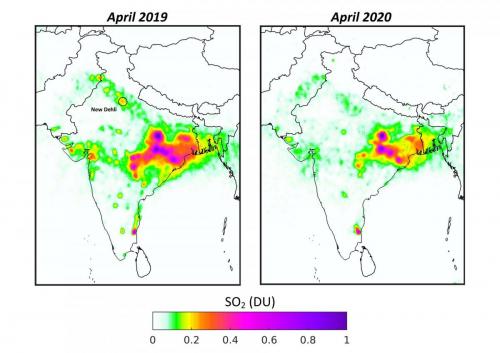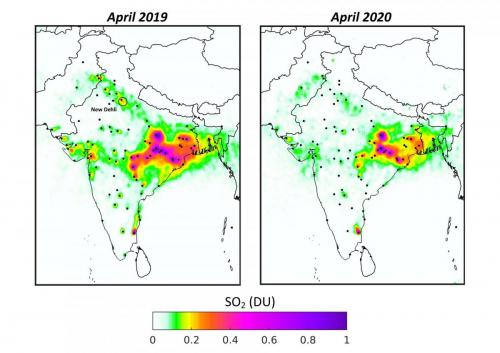Sulphur dioxide concentrations drop over India during COVID-19
Concentrations of sulphur dioxide in polluted areas in India have decreased by around 40% between April 2019 and April 2020. Using data from the Copernicus Sentinel-5P satellite, from the European Union Copernicus programme, scientists have produced new maps which show the drop in concentrations across the country in times of COVID-19.
In a report by Greenpeace last year, India was named the world’s largest emitter of anthropogenic sulphur dioxide – a significant contributor to air pollution. Sulphur dioxide causes many health-related problems, can harm sensitive ecosystems and is also a precursor to acid rain.

While some atmospheric sulphur dioxide is produced from natural processes, such as volcanoes, a substantial amount is produced by human activities – predominantly from power plants burning fossil fuels.

Sulphur dioxide concentrations over India
www.esa.int/Applications/Observing_the_Earth/Copernicus/Sentinel-5P/Sulp...
In India, emissions of sulphur dioxide have strongly increased over the last ten years, exacerbating haze problems over large parts of the country. However, owing to the COVID-19 pandemic, human and industrial activity dropped considerably since the beginning of its lockdown on 25 March 2020.

SO2 concentrations and location of power plants in India.
In a report by Greenpeace last year, India was named the world’s largest emitter of anthropogenic sulphur dioxide – a significant contributor to air pollution. Sulphur dioxide causes many health-related problems, can harm sensitive ecosystems and is also a precursor to acid rain.
While some atmospheric sulphur dioxide is produced from natural processes, such as volcanoes, a substantial amount is produced by human activities – predominantly from power plants burning fossil fuels.
In India, emissions of sulphur dioxide have strongly increased over the last ten years, exacerbating haze problems over large parts of the country. However, owing to the COVID-19 pandemic, human and industrial activity dropped considerably since the beginning of its lockdown on 25 March 2020.
The maps above show the averaged sulphur dioxide concentrations in April 2019, compared to April 2020. The darker shades of red and purple depict greater concentrations of sulphur dioxide in the atmosphere, while the black dots indicate the locations of the large, coal-fired power plants.
Sulphur dioxide concentrations have dropped significantly compared to the previous year, notably over New Delhi, over many large coal-fired power plants as well as other industrial areas. Some large plants in the northeast states of Odisha, Jharkhand, and Chhattisgarh have maintained a substantial level of activity, while others appear to have ceased entirely.
This analysis was produced by using data from the Tropomi instrument on the Copernicus Sentinel-5P satellite. A recent algorithm improvement, completed by the Royal Belgian Institute for Space Aeronomy (BIRA-IASB), allows the team to better picture the evolution of anthropogenic sulphur dioxide emissions over the country.
Nicolas Theys, from BIRA-IASB, comments, “We are very pleased with the new algorithm development as it is very sensitive to low sulphur dioxide concentrations caused by anthropogenic activities. As compared to the operational processor, the sensitivity and accuracy for anthropogenic emission detection has increased by an order of magnitude.”
ESA’s Copernicus Sentinel-5P mission manager, Claus Zehner, adds, “With our operational product, we can reliably measure strong sulphur dioxide concentrations emitted by volcanoes, but we have problems in detecting anthropogenic sulphur dioxide emissions. This new algorithm will enable new applications, for example in verifying existing sulphur dioxide emission inventories, after it has been implemented into the operational Sentinel-5P processing chain at the German Aerospace Center.”
Source: European Space Agency
- 371 reads
Human Rights
Conscience, Hope, and Action: Keys to Global Peace and Sustainability

Ringing FOWPAL’s Peace Bell for the World:Nobel Peace Prize Laureates’ Visions and Actions

Protecting the World’s Cultural Diversity for a Sustainable Future

The Peace Bell Resonates at the 27th Eurasian Economic Summit

Puppet Show I International Friendship Day 2020

